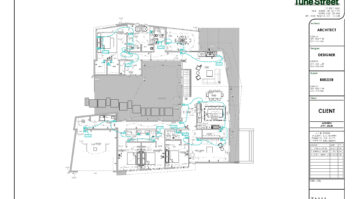The ancient Hindu parable of the blind men and an elephant is a story of a group of men, who, having never previously encountered an elephant, form a perception of the animal based on the only part they touch–one, the side; another, the leg; another, an ear; and so on. Their perception of the whole is thus limited to their individual experience. If they were to initiate a discussion about elephants, they would find themselves in disagreement. There would be no way for them to have a useful conversation about elephants unless each was willing to listen to the insights of the others. If that were to occur, together, they could effectively realize the truth of that wonderful beast.
Often a private theater design resembles that parable. A designer of one specialization creates a concept that is strongly skewed by their priority, resulting in compromised accommodation of one or more other necessary considerations. To video specialists, it is all about the image; audio enthusiasts will sacrifice much for pure sound; interiors can compromise performance in the pursuit of elegance–and architectural purity does not always support a high-performance configuration. Unfortunately, it is common that one or more specialist will refuse to budge at the expense of the ultimate result. It does not have to be this way.
It is vital to understand the fact that a high-quality private theater will require a team. There is a lot of rhetoric about “one-stop shop” and “turnkey” being thrown about, but if we truly analyze fine private theater projects, it is clearly not possible. Even if one organization were to provide all the equipment, seating, acoustical devices, and interior finishes, integration of those parts will require a skilled and cooperative team to bring about a truly spectacular result.
While it is true that simplified solutions exist, it is important to fit the solution to the client’s specific design sensibilities and performance requirements. Clientele who regularly acquire the finest things will be sold short by providing “off-the-shelf” solutions. They will be disappointed by one-dimensional design but thrilled by a truly integrated effort. One recent client, upon entering his bespoke room, broke into a beaming smile and rushed to assemble his family to see how it had turned out. The theater, a combined effort of room engineering, system engineering, design integration, and carefully managed construction epitomized a truly one-of-a-kind result with profound performance. How is this accomplished?
Discover: It is important to find out who else will be involved in the project and what influence, as well as capabilities, they might bring. Is the architect hands-on in relation to the interiors, and do they have structural engineering available in-house for elements like oversized projector housings? Will they be forthcoming with CAD drawings? Does the interior designer have a style concept in mind or already developed? Has the mechanical contractor planned for an independent system? Is there adequate power available for equipment and lighting? It is likely that no one is communicating all the concerns with the whole team, and it is a vital that everyone is coordinated.
Designate: Once the team is established, designate clear demarcations of scope. Work out where core competencies within the team exist. An effective scenario would be the acoustician providing all predictive modeling and treatment specifications while the systems engineer works out the equipment specification. The interior designer will develop an aesthetic but in concert with the acoustician and systems engineers’ requirements. The architect may provide some support documentation for modifications, if needed, as well as structural engineering. The general contractor with his team of subs will address mechanical modifications, increased power requirements, and gear up for the specialty construction required to deliver a high-performance private theater.
Document: Documentation is the language of construction, and private theaters require an exacting level of detail in it. Design documentation allows concepts to be communicated for all purposes, from obtaining accurate bids to collaborating between team members on concepts, directing craftsmen in the execution of details, and serving as a reference for quality assurance. It is also the language of performance. Acoustical modeling results disclose the expected sonic performance of a space, enabling verification at commissioning and mandating a level of expertise in this important task. Engineering specifications demand the systems driving the theater maintain a standard of performance based on objective standards.
Ultimately, the finest theaters represent excellence on many levels. Like the elephant in our parable, it is the diversity in characteristics that make it magnificent. Which attribute is it then, that defines a fine private theater? Better yet, which would you do without?







